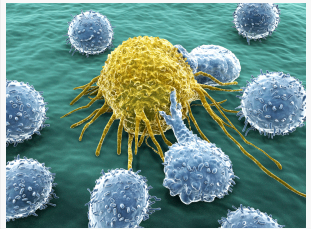A group from Hebrew University of Jerusalem has discovered the mechanism by which cells with actively replicating HHV-6 evade elimination by natural killer (NK) cells. HHV-6 suppresses the expression of surface proteins that alert immune cells by triggering two major receptors on NK cells: NKG2D and NKp30. They also identified B7-H6, a ligand for the activation of natural killer cell activating receptor NKp30, as a novel target for viral immune modulation.
By monitoring HHV-6B infected SupT1 cells at several time points post-infection, the group found that infected cells sensed the viral intruder and rapidly increased mRNA levels of all NKG2D ligands to alert the immune system, but HHV-6B responded by inhibiting the surface expression of NK ligands. The targets for HHV-6B were the stress-induced ligands MICB, ULBP1, and ULBP3, which trigger the receptor NKG2D, and B7-H6, which triggers NKp30. However, the surface expression of two other ligands, MICA and ULBP2, increased over time.

The Mandelboim laboratory at the Lautenberg Center for General and Tumor Immunology, The Hebrew University Hadassah Medical School, Jerusalem, Israel.
Further testing revealed that NKG2D ligands were regulated post-translationally by proteasomal degradation, while B7-H6 was targeted at the transcriptional level. The results indicated that at least two independent viral proteins were involved in regulating NKG2D ligands, and at least one other viral mechanism was involved in targeting B7-H6 at the mRNA level. The authors note that as the expression of the viral proteins that suppress the cellular stress ligands occurs less than 12 hours after infection, they are likely some of the initial viral proteins expressed, which highlights the importance of avoiding NK cell recognition.
The fact that HHV-6 can establish a latent infection and reactivate intermittently suggests that the virus utilizes evasion techniques, but very little study has been done to determine the mechanisms. We do know that the virus suppresses antiviral interferon response (Jaworska 2007), that both HHV-6A and HHV-6B productively infect CD4+ cells, that HHV-6A can infect both NK cells and CD8+ cells, and that both viruses interfere with immune function via cytokine and chemokine expression (Dagna 2013). In addition, it has been shown that HHV-6 inhibits T cell activation and impairs T cell receptor activity by transcriptional downregulation of the signaling domain of the receptor, CD247, and at least in the case of HHV-6A, by endocytosis of the receptor complex mediated by the viral protein U24 (Lusso 1991, Sullivan 2008).
To read the full paper, see Schmiedel 2016.

